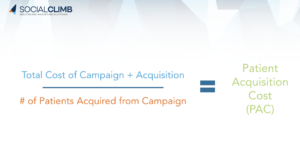3 Ways to Use Technology to Boost Patient Lifetime Value
By Chloe From Clearwave | May, 2024
We recently published an article on reducing patient acquisition costs (PAC) and meeting patient demand with online scheduling, which highlights key takeaways from a LinkedIn Live we participated in with our partner, SocialClimb. We broke down how to calculate PAC and provided recommendations for lowering it – the greatest of which is by increasing conversation rates with digital, patient self-scheduling.
In this second installment of our patient acquisition series, we’re going to focus on how to ensure strong patient lifetime value after you’ve gotten them in the door. Teaser:
Patient Acquisition Cost (PAC) Recap
If you didn’t catch our last blog, here’s a brief overview of the PAC formula:
Marketers use a variety of different marketing channels to acquire new patients – some are expensive, and others are more cost-effective. The “total cost of campaign” element is the cumulative cost of all marketing tactics used in any one campaign. The end goal of these campaigns is to get patients to book an appointment either by scheduling online or by calling into a practice. The costs associated with these scheduling strategies make up the “acquisition method.” Once you have each of these numbers, you can add them together and then divide the sum by the number of patients your practice acquired as a result of your campaign.
Knowing PAC helps marketers understand conversion rates and whether marketing campaigns are demonstrating a return on investment.
Grow Faster by Increasing Patient Lifetime Patient Value
Knowing PAC is instrumental in developing and implementing a cost-effective and successful patient acquisition strategy. But, when it comes to practice growth, acquisition is only half the equation. The other half is patient retention. Getting patients to make an initial appointment is a win, but will they come back? That depends on whether your retention strategies are working.
Calculating lifetime patient value (LPV) is a good benchmark indicating whether your retention approach is effective. Here’s the LPV formula:
Average Value of Appointment X Average # of Appointments a Year X Average Number of Years Patients Visit Your Practice = LPV
For example, let’s say the average value of an appointment is $300, and “Patient A” goes twice a year and stays with the practice for 5 years. You would calculate the LPV of “Patient A” like this: $300 x 2 x 5 = $3,000.
Simple enough, right? But, there’s more. In addition to knowing LPV, it’s also helpful to calculate your Marketing Growth Multiplier (MGM) – and this often slips under the radar in marketing discussions. In simple terms, MGM calculates, for every dollar spent, how much you get in return. For example, for every $1 spent, a practice might get $3 in return. Here’s the formula:
LPV ÷ PAC = MGM
When it comes to MGM, a good baseline is a minimum of 3x your multiplier. If you’re there, great! You can now work to stretch your goal even further. If your multiplier is under 3x, not to worry; there are strategies to boost these results. Here are three to consider:
- Focus on patient retention efforts: If you find ways to meet patients where they are and provide the access to care they demand (self-service scheduling and registration, improved communication, simplified payments, etc.,) LPV will naturally increase along with patient retention.
- Improve marketing conversion: If you have the right audience but aren’t converting high, consider evaluating your messaging – it may need to be refreshed.
- Optimize marketing channels: As this is the foundation for the “total cost of campaign” factor, your strategy here is vital to reducing PAC.
If your practice wants to make marketing more metrics-driven, PAC, LPV and MGM are all great formulas to consider.
Increasing the Lifetime Value of Your Patient Base
LPV is critical for practice growth, so you want to achieve the best results possible. High-performing practices are leaning into technology to transform the patient experience to drive acquisition and retention and grow profits. Here are three ways you can follow in their footsteps:
- Make online, self-service scheduling a priority
Patients think about their healthcare needs at all hours of the day, not just during a practice’s hours of operation, so providers need to be extremely accessible to both new and existing patients. Patients of all generations now demand the same on-demand, digital access in their healthcare interactions as they do in other aspects of their lives. Practices that fail to meet these expectations with online, self-scheduling miss out on a big opportunity to increase new patients, retain existing ones and grow their practice. Offering online, self-service scheduling that allows patients to book appointments while they’re top of mind–whether that’s at night, on the weekend or during a holiday—is an integral part of the strategy.
Online, self-service scheduling meets patient demand for flexibility to book appointments online anytime, anywhere, without human interaction, while increasing patient acquisition, retention and revenue. The right solution will also meet your providers’ scheduling requirements and improve accuracy, learn more in this guide, “The Top 5 Patient Self-Scheduling Myths Busted!”
- Keep patients informed about their care with custom appointment reminders
Sending automated appointment reminders is a simple yet effective way to remind patients of their visit. This builds loyalty and satisfaction with patients while reducing no-shows for your practice. Considering 1 in 3 patients missed appointments due to not having a reminder and 30% of patients who no-show never return to the same practice — your reminders strategy is more crucial than ever. How much could no-shows be costing your practice and providers?
One study found that no-shows cost the U.S. healthcare system more than $150 billion a year and individual physicians an average of $200 per unused time slot.
The most effective patient messaging solutions offer appointment reminders with a digital self-service scheduling link, enabling patients to confirm, cancel or reschedule appointments. Just as patients don’t want to call a practice to schedule an initial appointment, they also don’t want to have to pick up the phone to cancel or change a scheduled visit. Practices that force patients to do this risk no-shows that lead to missed revenue not only from that particular patient but also from appointment gaps that otherwise could have been filled with urgent, same-day or waitlist visits.
Automated appointment reminders with digital confirmation and rescheduling options provide a better patient experience that maximizes bookings, patient throughput and practice revenue. If you want to evaluate your existing no-show approach and look for opportunities for improvement, consider the strategies in this guide on, “3 Ways To Use Patient Communications to Boost Revenue.”
- Create a check-in experience that satisfies patients with short wait times and discrete bill pay
Another major source of patient frustration is having to arrive to for an appointment well ahead of their scheduled time just to fill out a massive stack of paper forms. Research reveals that 2 out of 5 patients are frustrated with their provider before their visit due to long wait times at check-in. Additionally, nearly 50% of patients want the ability to check in or complete health forms before arriving to their provider’s office.
Patient self-service registration and check-in removes this pain point by allowing patients to digitally self-register ahead of their appointment via their computer, tablet or mobile phone, or on-site via a kiosk. Both options offer drastically reduced check-in and wait times for patients, delivering a better patient experience that helps with reputation and incites positive ratings for even greater acquisition. Considering 73% of patients say they keep a “mental scorecard” of all the things they like and dislike about a new doctor’s office, including factors such as timeliness and use of modern technology, now is time to lean in to solutions to help you keep patient scorecards high.
Self-service registration also prompts payment at the point-of-service – without staff intervention. When patients can make payments privately, comfortably and easily, your practice can see upwards of a 112% increase in point-of-service collections and immediate revenue improvements.
Organization-wide Technology Benefits
In addition to transforming the patient experience for increased patient acquisition, retention and lifetime value, technology also provides benefits across the practice, including by:
- Taking the administrative burden off front desk workers: Data capture, eligibility verification, appointment reminders, payment processing and other processes can be digitized, making employees’ workloads more manageable so they can focus on what’s most important: patient care.
- Optimizing operations to reduce cost: When administrative and financial operations are automated and streamlined, they become more efficient, bringing down the overall cost associated with each patient.
- Automating data capture for cleaner claims: With accurate data, Clearwave customers have seen a 94% drop in their claims rejection rate, subsequently minimizing resubmission costs and increasing realized revenue per patient.
- Ensuring consistent payment: Prompting accurate co-pay collection and payment at every patient check-in helps to minimize post-visit billing challenges, credits and refunds and administrative headaches.
- Increased revenue opportunities: Enabling streamlined, consistent and targeted messaging to promote premium services to the right audiences to drive revenue. Thomas Eye Group took this approach and realized more than $400,000 in new LASIK revenue.
Modernize to Improve Patient Lifetime Value and Profit Growth
Technology is the key to modernizing your practice in a way that meets patient expectations, accelerating acquisition, retention and profits. It can also help you keep staff satisfied, earn more revenue for each patient and bring your practice to the next level. To learn more about this topic, watch the full 20-minute LinkedIn Live discussion, “Balancing Patient Acquisition Cost with Patient Lifetime Value.”
Learn more about SocialClimb, the Healthcare Marketing Platform here.





